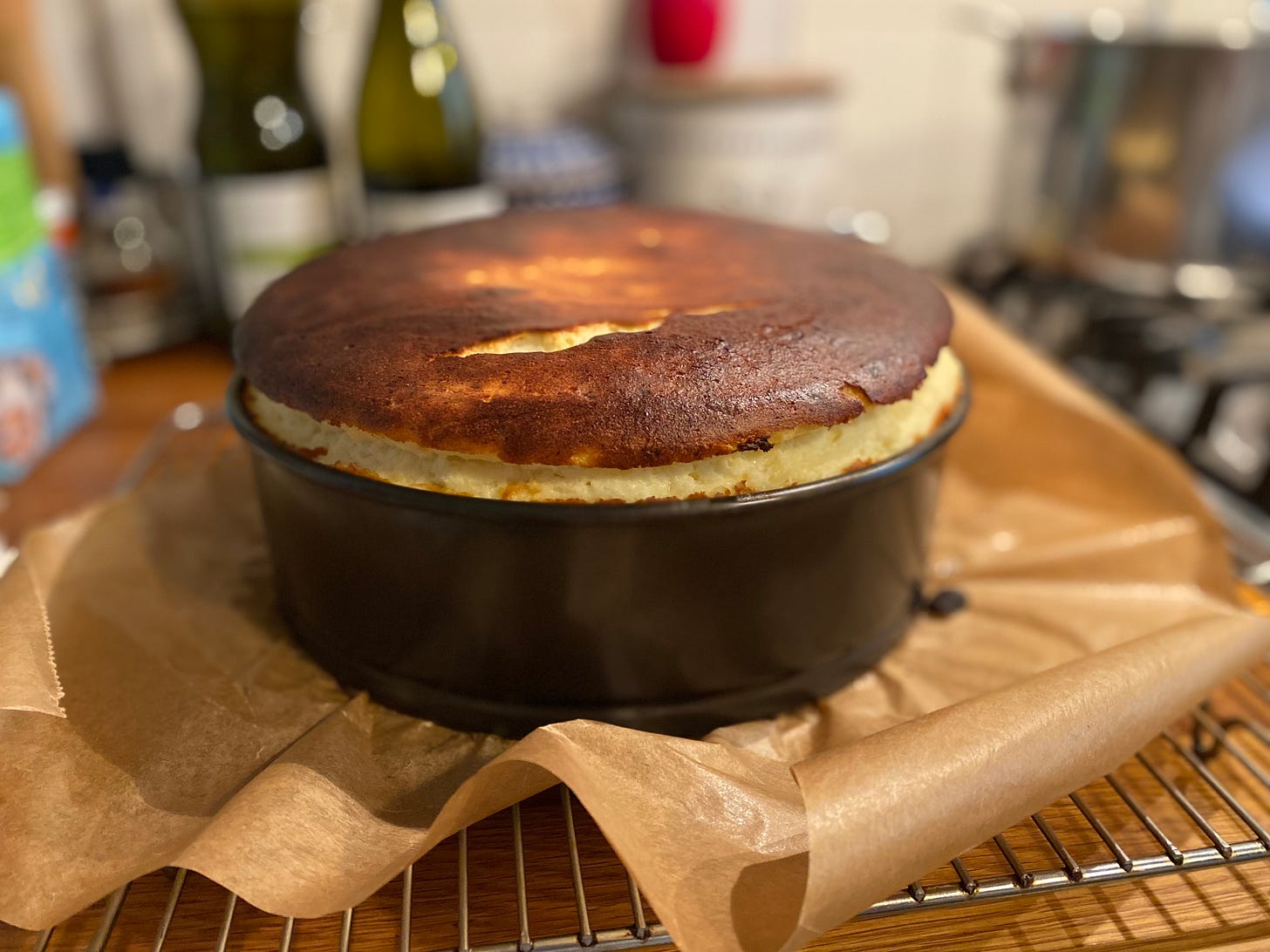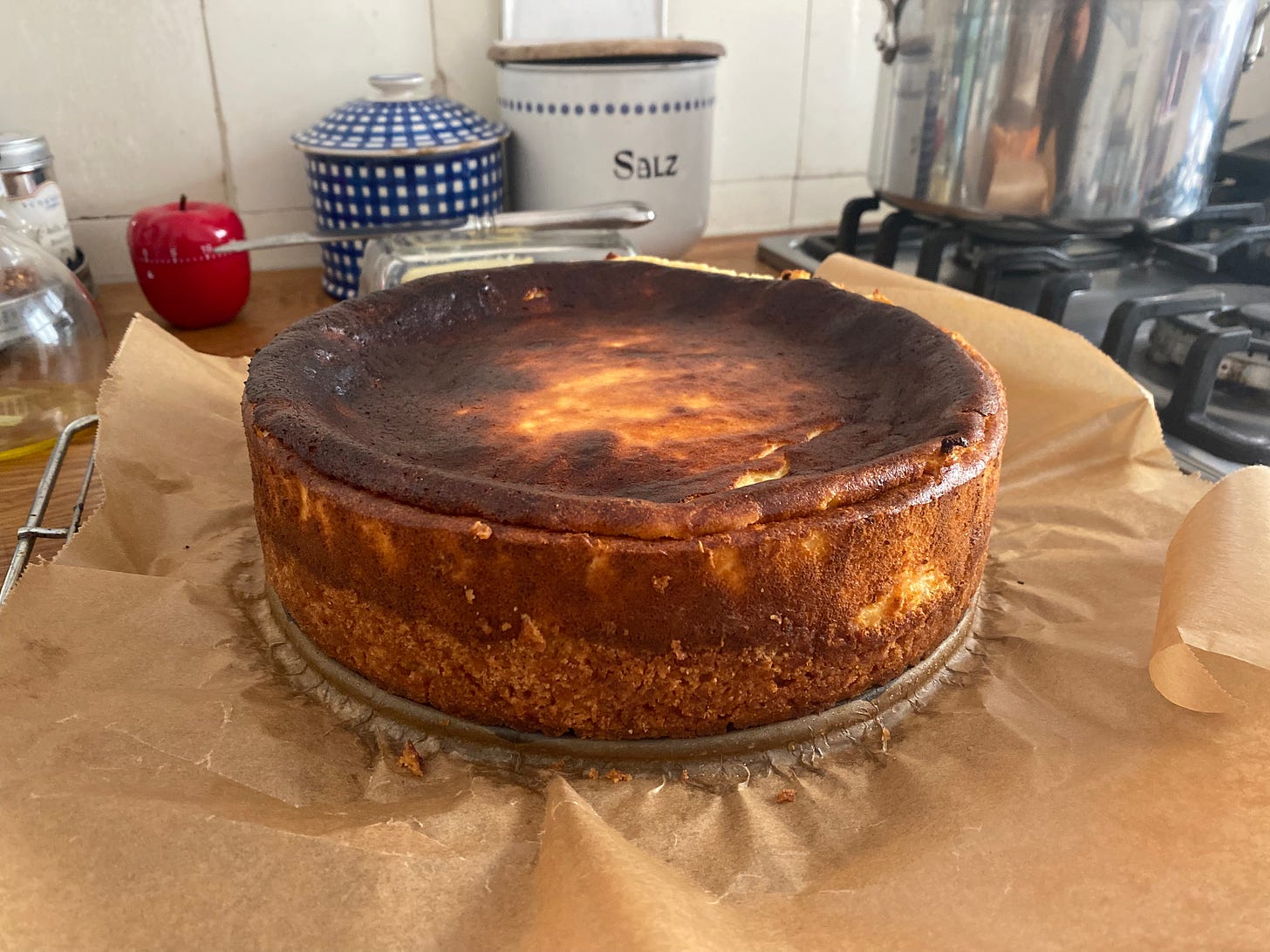My cookbook Classic German Baking came out six and a half years ago and it really never stops getting old to me, the fact that I can walk up to my shelf, pull out this book and bake something from it that I love. I continue to be really proud of it. I recently learned that in some circles it is frowned upon to promote your book more than a year after it was written, to which I can only say, I spent 18 months baking ten cakes a day1 and you think I won’t crow about this achievement until the day I die?
One general complaint about the cookbook was that there weren’t enough photographs of the finished recipes. I agree! If I could have, I would have included far more photographs, especially of the recipes that I loved the most, like Käsekuchen, classic German Quark cheesecake. It is, if I do say so myself, a triumph.
The recipe is adapted from one that I found in Die Zeit, a serious weekly newspaper with a wonderful food section. The accompanying article was all about how difficult it was, even for Germans, to crack the code of perfect Käsekuchen2, and the author lamented the miserable state of contemporary store-bought specimens. Several bakers, as well as the head of a pastry school in Berlin, were interviewed, and strong feelings about regional differences in German cheesecakes were aired. Popular from north to south and east to west, Käsekuchen may well be Germany’s national cake. There are too many versions of them to count (my cookbook alone has four), but the one thing they all have in common is the use of Quark.
Quark, a sour fresh cheese that has been a staple in east and central Europe for hundreds if not thousands of years, is essential to the German kitchen. It is grainier and leaner than ricotta, to which it is often erroneously compared. High in protein and low in fat, Quark is quite versatile. It is often eaten at breakfast, either as a spread or mixed with fruit and muesli, but is also a typical accompaniment, when herbed and salted, for boiled potatoes. Quark is also an essential ingredient in the German and Austrian sweet kitchen, showing up in cake batters and fillings, soufflés and dumplings. I recently read Ursula Heinzelmann’s excellent history of German food, Beyond Bratwurst, where I learned that the Roman historian Tacitus penned one of the first written records of the diet of “wild” German tribes that included lac concretum (widely assumed to be Quark). That was in the 1st century A.D.!
The filling for my Käsekuchen calls for almost an entire kilo of Quark, lightened with a mound of beaten egg whites and enriched with a bit of whipped cream. Poured into a par-baked short crust, the filling puffs up impressively in the oven. Since this enormous amount of filling is still only baked in a 9-inch pan, the cake comes out gorgeously thick, making for truly satisfying wedges. Trust me, you won’t want just a thin sliver. While Quark is a staple food here in Germany (and in Austria), it can be hard to find in stores elsewhere. Luckily, it’s easily made at home with buttermilk and an oven. A recipe follows below.
Despite its height, this Käsekuchen is neither too rich nor too sweet; the Quark keeps it faintly sour and wonderfully light and satisfying. A fat wedge can be put away without any deleterious effects and can be served at nearly any time of year. Although I happen to think it is especially nice in spring and summer. It is the perfect dessert for Easter lunch, cool and fresh-tasting, or what you’d like to eat in the afternoon for tea.
Only one note on serving: if possible, the cake should be made a day in advance of serving. Freshly baked, it has an airy, fluffy quality, which—after refrigeration—settles into something thicker and creamier and deeply satisfying.

Classic Quark Cheesecake
Makes one 9-inch/23-cm round cake
Crust:
200 grams all-purpose flour (1 2/3 cups, scooped and leveled, minus 1 tablespoon)
100 grams granulated sugar (1/2 cup)
Pinch of salt
1 large egg
100 grams unsalted butter, softened and cut into cubes (7 tablespoons)
Filling:
900 grams Quark (3 2/3 cups) (see recipe below)
90 ml whole milk (6 tablespoons)
190 grams granulated sugar (1 cup minus 1 tablespoon)
45 grams cornstarch (1/3 cup)
1/2 teaspoon vanilla extract
6 eggs, separated
1/4 teaspoon salt
90 ml whipping cream (6 tablespoons)
First, make the crust. Mix the flour, sugar and salt together in a mixing bowl. Add egg and the butter and knead together until a smooth dough forms. Wrap in plastic wrap and refrigerate for 30 minutes. You can make this up to a day in advance.
Preheat the oven to 200°C/400°F. Line a 9-inch/23-cm springform pan with a piece of parchment paper.
Press the dough evenly into the pan, creating a 5-cm/2-inch-high rim. Line the crust with aluminum foil and fill with pie weights or dried beans. Bake for 25 minutes.
While the crust is baking, make the filling: Place the Quark, milk, sugar, cornstarch, vanilla and egg yolks in a very large mixing bowl and whisk together until creamy and smooth. In a separate bowl, whip the egg whites and salt together until the egg whites hold stiff peaks. Fold into the Quark mixture. Whip the cream until thick. Fold into the Quark mixture.
When the crust has finished baking, remove the pan from the oven and immediately remove the aluminum foil and weights; maintain the oven temperature. If the crust has slumped down in the pan and thickened, use the back of a metal measuring cup or large spoon to press the crust back up the sides of the pan and even it out.
Scrape the Quark mixture into the hot crust. The filling will come up over the crust almost to the edge of the pan. Gently place the pan back in the oven and bake for 30 minutes. Remove from the oven and insert the tip (2.5 cm/1 inch) of a very sharp knife horizontally into the portion of the Quark filling that has risen up over the edge of the pan. Holding the knife steady, run it all the way around the cake. This will keep the cake from cracking later. Maintain the oven temperature.
Place the pan back in the oven and bake for an additional 20 minutes. After 10 minutes, you may need to cover the top of the cake with a piece of aluminum foil to keep it from browning too much. When it’s done, the cake should be golden brown and wobble gently in the center when jiggled. Remove the cake from the oven and let it cool completely on a rack before loosening and removing the springform ring.
The cake can be served the day it is made, but it improves with a day of rest in the refrigerator. The cake will keep for up to 5 days, refrigerated.
Homemade Quark
Makes between 750 and 1000 grams, depending on how long you drain it
3 liters buttermilk (12 1/2 cups)
Preheat the oven to 65°C/150°F. Pour the buttermilk into a large baking dish and cover tightly with aluminum foil.
Place the baking dish in the oven and bake for 8 to 12 hours. When the buttermilk is ready to drain, the solids will have separated from the whey, either in soft clumps or in one uniform mass.
Place a fine-mesh sieve over a large pot and line the sieve with cheesecloth. Remove the pan from the oven and pour the contents of the pan into the sieve. Let sit for at least 2 hours and as long as 5 hours. Then pick up the corners of the cheesecloth and twist to squeeze out any residual moisture in the Quark.
The Quark can be refrigerated in an airtight container for several days or used immediately. Any leftover Quark can be used as a spread on bread or mixed with fruit for breakfast or a snack.
Only slightly inaccurate, because sometimes it was ten cookies. Or ten strudels. Or ten rolls.
Pronounced KAY-zuh-KOO-khenn




I need to make this! What fat content does the Quark you use /prefer have?
I can't believe it's been 6 1/2 years. But that book has provided me with not only some of my favorite things to eat EVER, but total comfort in an unbelievably destabilizing and often nerve-racking world. Thank you for putting it into the world.